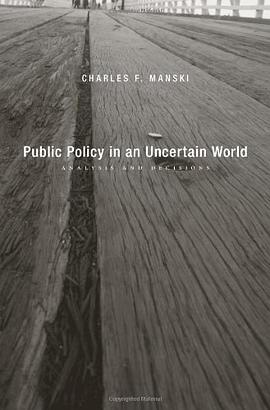Public Policy in an Uncertain World
豆瓣
Analysis and Decisions
Charles F. Manski
简介
Manski argues that public policy is based on untrustworthy analysis. Failing to account for uncertainty in an uncertain world, policy analysis routinely misleads policy makers with expressions of certitude. Manski critiques the status quo and offers an innovation to improve both how policy research is conducted and how it is used by policy makers.
Policy analysis, like all empirical research, combines assumptions and data to draw conclusions about a population of interest. The logic of empirical inference is summarized by the relationship: assumptions + data → conclusions. Data alone do not suffice to draw conclusions. Inference requires assumptions that relate the data to the population of interest … Holding fixed the available data, and presuming avoidance of errors in logic, stronger assumptions yield stronger conclusions. At the extreme, one may achieve certitude by posing sufficiently strong assumptions. [However,] the credibility of inference decreases with the strength of the assumptions maintained … Researchers regularly express certitude about the consequences of alternative [policy] decisions. Exact predictions of outcomes are common, and expressions of uncertainty are rare. Yet policy predictions are often fragile. Conclusions may rest on critical, unsupported assumptions or on leaps of logic. Then the certitude of policy analysis is not credible.
contents
Preface
Introduction
Rumsfeld and the Limits to Knowledge
Using Policy Analysis to Inform Decisions
Organization of the Book
I. Policy Analysis
1. Policy Analysis with Incredible Certitude
1.1 The Logic and Credibility of Policy Analysis
1.2 Incentives for Certitude
Support for Certitude in Philosophy of Science
1.3 Conventional Certitudes
CBO Scoring of Pending Legislation
Scoring the Patient Protection and Affordable Care Act of 2010
Credible Interval Scoring
Can Congress Cope with Uncertainty?
British Norms
1.4 Dueling Certitudes
The RAND and IDA Reports on Illegal Drug Policy
The National Research Council Assessment
1.5 Conflating Science and Advocacy
Friedman and Educational Vouchers
1.6 Wishful Extrapolation
Selective Incapacitation
Extrapolation from Randomized Experiments: The FDA Drug Approval Process
The Study Population and the Population of Interest
The Experimental Treatments and the Treatments of Interest
The Outcomes Measured in Experiments and the Outcomes of Interest
The FDA and Conventional Certitude
Campbell and the Primacy of Internal Validity
1.7 Illogical Certitude
Heritability
What Does “More Important“ Mean?
Heritability and Social Policy
Gene Measurement
1.8 Media Overreach
“The Case for $320,000 Kindergarten Teachers“
Peer Review and Credible Reporting
2. Predicting Policy Outcomes
2.1 Deterrence and the Death Penalty
Estimates Using Data on Homicide Rates across States and Years
2.2 Analysis of Treatment Response
Statistical Inference and Identification
2.3 Predicting Outcomes under Policies That Mandate a Treatment
Sentencing and Recidivism
Background
Our Analysis
Analysis Assuming Individualistic Treatment Response
Numerical Findings
Choosing a Policy
2.4 Identical Treatment Units
Before-and-After Studies
Difference-in-Differences Studies
Employment in Fast-Food Restaurants and the Minimum Wage
2.5 Identical Treatment Groups
Experiments with Random Assignment of Treatments
The “Gold Standard“
2.6 Randomized Experiments in Practice
Extrapolation
Compliance
The Illinois Unemployment Insurance Experiment
Random Compliance
Intention-to-Treat
The Mixing Problem
Extrapolation from the Perry Preschool Project
Social Interactions
Local and Global Interactions
Credible Analysis of Experimental Data
2.7 Random Treatment Choice in Observational Studies
Rational Treatment Choice and Selection Bias
Outcome Optimization with Perfect Foresight
Regression Discontinuity Analysis
2.8 Modeling Rational Treatment Choice
Outcome Optimization as a Model of Sentencing
Distributional Assumptions
3. Predicting Behavior
3.1 Income Taxation and Labor Supply
The Theory of Labor Supply
Empirical Analysis
Basic Revealed-Preference Analysis
Illustration: Labor Supply under Progressive and Proportional Taxes
3.2 Discrete Choice Analysis
Random Utility Model Representation of Behavior
Attribute Representation of Alternatives and Decision Makers
Analysis with Incomplete Attribute Data
Practicality
College Choice in America
Predicting the Enrollment Effects of Student Aid Policy
Power and Price of the Analysis
Discrete Choice Analysis Today
3.3 Predicting Behavior under Uncertainty
How Do Youth Infer the Returns to Schooling?
How Do Potential Criminals Perceive Sanctions Regimes?
Measuring Expectations
Pill, Patch, or Shot?
3.4 Perspectives on Rational Choice
As-If Rationality
Bounded Rationality
Biases and Heuristics
Widespread Irrationality or Occasional Cognitive Illusions?
The Common Thread Is Certitude
II. Policy Decisions
4. Planning with Partial Knowledge
4.1 Treating X-Pox
4.2 Elements of Decision Theory
States of Nature
The Welfare Function
Welfare Functions in Studies of Optimal Income Taxation
The Mirrlees Study
4.3 Decision Criteria
Elimination of Dominated Actions
Weighting States and the Expected Welfare Criterion
Criteria for Decision Making under Ambiguity
Maximin
Minimax Regret
Using Different Criteria to Treat X-Pox
4.4 Search Profiling with Partial Knowledge of Deterrence
4.5 Vaccination with Partial Knowledge of Effectiveness
Background
Internal and External Effectiveness
The Planning Problem
Partial Knowledge of External Effectiveness
Choosing a Vaccination Rate
4.6 Rational and Reasonable Decision Making
The Savage Argument for Consistency
Axiomatic Rationality and Actualist Rationality
Axiomatic and Actualist Perspectives on Subjective Probability
Ellsberg on Ambiguity
The Quest for Rationality and the Search for Certitude
5. Diversified Treatment Choice
Diversification and Profiling
5.1 Allocating a Population to Two Treatments
The Welfare Function
A Status Quo Treatment and an Innovation
Expected Welfare
Maximin
Minimax Regret
Choosing Sentences for Convicted Juvenile Offenders
Allocation of Wealth to a Safe and Risky Investment
Risk-Averse Planning
5.2 Diversification and Equal Treatment of Equals
Ex Ante and Ex Post Equal Treatment
Combining Consequentialism and Deontological Ethics
5.3 Adaptive Diversification
Adaptive Minimax Regret
Implementation in Centralized Health Care Systems
The AMR Criterion and the Practice of Randomized Clinical Trials
Fraction of the Population Receiving the Innovation
Group Subject to Randomization
Measurement of Outcomes
5.4 Diversification across Time or Space
Diversification by Cohort
Laboratories of Democracy
5.5 Adaptive Partial Drug Approval
The Present Approval Process
Binary versus Partial Approval
Adaptive Partial Licensing
5.6 Collective Decision Processes
Majority-Rule Voting with Single-Peaked Preferences
The Credibility of Single-Peaked Preferences
Strategic Interactions
Learning and Heterogeneity of Policy Preferences
Bilateral Negotiations
Pareto Optimal Allocations
Incentive-Compatible Processes
Teacher Evaluation in New York City
5.7 Laissez-Faire
Social Learning from Private Experiences
Laissez-Faire Learning and Adaptive Diversification
6. Policy Analysis and Decisions
Institutional Separation of Analysis and Decisions
Doing Better
Appendix A: Derivations for Criteria to Treat X-Pox
Appendix B: The Minimax-Regret Allocation to a Status Quo Treatment and an Innovation
Appendix C: Treatment Choice with Partial Knowledge of Response to Both Treatments
References
Index
